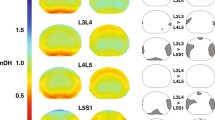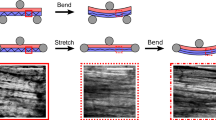Abstract
There is a high incidence of low back pain (LBP) associated with occupations requiring sustained and/or repetitive lumbar flexion (SLF and RLF, respectively), which cause creep of the viscoelastic tissues. The purpose of this study was to determine the effect of creep on lumbar biomechanics and facet joint capsule (FJC) strain. Specimens were flexed for 10 cycles, to a maximum 10 Nm moment at L5-S1, before, immediately after, and 20 min after a 20-min sustained flexion at the same moment magnitude. The creep rates of SLF and RLF were also measured during each phase and compared to the creep rate predicted by the moment relaxation rate function of the lumbar spine. Both SLF and RLF resulted in significantly increased intervertebral motion, as well as significantly increased FJC strains at the L3-4 to L5-S1 joint levels. These parameters remained increased after the 20-min recovery. Creep during SLF occurred significantly faster than creep during RLF. The moment relaxation rate function was able to accurately predict the creep rate of the lumbar spine at the single moment tested. The data suggest that SLF and RLF result in immediate and residual laxity of the joint and stretch of the FJC, which could increase the potential for LBP.
Similar content being viewed by others
References
Adams, M. A., and P. Dolan. Time-dependent changes in the lumbar spine’s resistance to bending. Clin. Biomech. (Bristol., Avon.) 11:194–200, 1996.
Bernard, B. P., and L. Fine. Musculoskeletal Disorders and Workplace Factors: Critical Review of Epidemiologic Evidence for Work-Related Musculoskeletal Disorders of the Neck, Upper Extremity, and Low Back, 2nd ed. Bethesda, MD: National Institute for Occupational Safety and Health, 1997.
Cavanaugh, J., A. Ozaktay, H. Yamashita, A. Avramov, T. Getchell, and A. King. Mechanisms of low back pain. Clin. Orthop. Relat. Res. 335:166–180, 1997.
Cavanaugh, J. M., A. C. Ozaktay, H. T. Yamashita, and A. I. King. Lumbar facet pain: Biomechanics, neuroanatomy and neurophysiology. J. Biomech. 29:1117–1129, 1996.
Chimich, D., N. Shrive, C. Frank, L. Marchuk, and R. Bray. Water content alters viscoelastic behaviour of the normal adolescent rabbit medial collateral ligament. J. Biomech. 25:831–837, 1992.
Claude, L. N., M. Solomonow, B. H. Zhou, R. V. Baratta, and M. P. Zhu. Neuromuscular dysfunction elicited by cyclic lumbar flexion. Muscle Nerve 27:348–358, 2003.
Findly, W. N., J. W. Lai, and K. Onaran. Creep and Relaxation of Nonlinear Viscoelastic Mateirals, with an Introduction of Linear Viscoelasticity. Amsterdam: North Holland, 1976.
Fung, Y. Biomechanics: Mechanical Properties of Living Tissues, 2nd ed. New York: Springer-Verlag, 1993.
Gardner-Morse, M. G., and I. A. Stokes. The effects of abdominal muscle coactivation on lumbar spine stability. Spine 23:86–91, 1998.
Gedalia, U., M. Solomonow, B. H. Zhou, R. V. Baratta, Y. Lu, and M. Harris. Biomechanics of increased exposure to lumbar injury caused by cyclic loading. Part 2. Recovery of reflexive muscular stability with rest. Spine 24:2461–2467, 1999.
Granata, K. P., and W. S. Marras. The influence of trunk muscle coactivity on dynamic spinal loads. Spine 20:913–919, 1995.
Hingorani, R. V., P. P. Provenzano, R. S. Lakes, A. Escarcega, and R. Vanderby, Jr. Nonlinear viscoelasticity in rabbit medial collateral ligament. Ann. Biomed. Eng. 32:306–312, 2004.
Hoffman, A. H., and P. Grigg. A method for measuring strains in soft tissue. J. Biomech. 17:795–800, 1984.
Ianuzzi, A., J. S. Little, J. B. Chiu, A. Baitner, G. Kawchuk, and P. S. Khalsa. Human lumbar facet joint capsule strains: I. During physiological motions. Spine J. 4:141–152, 2004.
Johannessen, W., E. J. Vresilovic, A. C. Wright, and D. M. Elliott. Intervertebral disc mechanics are restored following cyclic loading and unloaded recovery. Ann. Biomed. Eng. 32:70–76, 2004.
Kang, Y. M., W. S. Choi, and J. G. Pickar. Electrophysiologic evidence for an intersegmental reflex pathway between lumbar paraspinal tissues. Spine 27:E56–E63, 2002.
Keller, T. S., T. H. Hansson, S. H. Holm, M. M. Pope, and D. M. Spengler. In vivo creep behavior of the normal and degenerated porcine intervertebral disk: A preliminary report. J. Spinal Disord. 1:267–278, 1988.
Keller, T. S., S. H. Holm, T. H. Hansson, and D. M. Spengler. Volvo Award in experimental studies. The dependence of intervertebral disc mechanical properties on physiologic conditions. Spine 15:751–761, 1990.
Keller, T. S., D. M. Spengler, and T. H. Hansson. Mechanical behavior of the human lumbar spine. I. Creep analysis during static compressive loading. J. Orthop. Res. 5:467–478, 1987.
Koeller, W., S. Muehlhaus, W. Meier, and F. Hartmann. Biomechanical properties of human intervertebral discs subjected to axial dynamic compression–influence of age and degeneration. J. Biomech. 19:807–816, 1986.
Lakes, R. S., and R. Vanderby. Interrelation of creep and relaxation: A modeling approach for ligaments. J. Biomech. Eng. 121:612–615, 1999.
Little, J. S., A. Ianuzzi, J. B. Chiu, A. Baitner, and P. S. Khalsa. Human lumbar facet joint capsule strains: II. Alteration of strains subsequent to anterior interbody fixation. Spine J. 4:153–162, 2004.
Little, J. S., and P. S. Khalsa. Material properties of the human lumbar facet joint capsule. J. Biomech. Eng, 127:1–10, 2005.
Lu, D., M. Solomonow, B. Zhou, R. V. Baratta, and L. Li. Frequency-dependent changes in neuromuscular responses to cyclic lumbar flexion. J. Biomech. 37:845–855, 2004.
McGill, S. M., and S. Brown. Creep response of the lumbar spine to prolonged full flexion. Clin. Biomech. 7:43–46, 1992.
McLain, R. F., and J. G. Pickar. Mechanoreceptor endings in human thoracic and lumbar facet joints. Spine 23:168–173, 1998.
Oliver, M. J., and L. T. Twomey. Extension creep in the lumbar spine. Clin. Biomech. (Bristol., Avon.) 10:363–368, 1995.
Panjabi, M. M., M. Krag, D. Summers, and T. Videman. Biomechanical time-tolerance of fresh cadaveric human spine specimens. J. Orthop. Res. 3:292–300, 1985.
Provenzano, P. P., R. S. Lakes, D. T. Corr, and R. R. Vanderby, Jr. Application of nonlinear viscoelastic models to describe ligament behavior. Biomech. Model. Mechanobiol. 1:45–57, 2002.
Provenzano, P., R. Lakes, T. Keenan, and R. Vanderby, Jr. Nonlinear ligament viscoelasticity. Ann. Biomed. Eng. 29:908–914, 2001.
Race, A., N. D. Broom, and P. Robertson. Effect of loading rate and hydration on the mechanical properties of the disc. Spine 25:662–669, 2000.
Soderkvist, I., and P. A. Wedin. Determining the movements of the skeleton using well-configured markers. J. Biomech. 26:1473–1477, 1993.
Solomonow, M., R. V. Baratta, A. Banks, C. Freudenberger, and B. H. Zhou. Flexion-relaxation response to static lumbar flexion in males and females. Clin. Biomech. (Bristol., Avon.). 18:273–279, 2003.
Solomonow, M., R. V. Baratta, B. H. Zhou, E. Burger, A. Zieske, and A. Gedalia. Muscular dysfunction elicited by creep of lumbar viscoelastic tissue. J. Electromyogr. Kinesiol. 13:381–396, 2003.
Solomonow, M., Z. B. He, R. V. Baratta, Y. Lu, M. Zhu, and M. Harris. Biexponential recovery model of lumbar viscoelastic laxity and reflexive muscular activity after prolonged cyclic loading. Clin. Biomech. (Bristol., Avon.) 15:167–175, 2000.
Solomonow, M., B. H. Zhou, R. V. Baratta, Y. Lu, and M. Harris. Biomechanics of increased exposure to lumbar injury caused by cyclic loading: Part 1. Loss of reflexive muscular stabilization. Spine 24:2426–2434, 1999.
Thornton, G. M., A. Oliynyk, C. B. Frank, and N. G. Shrive. Ligament creep cannot be predicted from stress relaxation at low stress: A biomechanical study of the rabbit medial collateral ligament. J. Orthop. Res. 15:652–656, 1997.
Thornton, G. M., N. G. Shrive, and C. B. Frank. Ligament creep recruits fibres at low stresses and can lead to modulus-reducing fibre damage at higher creep stresses: A study in rabbit medial collateral ligament model. J. Orthop. Res. 20:967–974, 2002.
Twomey, L., and J. Taylor. Flexion creep deformation and hysteresis in the lumbar vertebral column. Spine 7:116–122, 1982.
White, A., and M. M. Panjabi. Clinical Biomechanics of the Spine, 2nd ed. Philadelphia: Lippincott, 1990.
Williams, M., M. Solomonow, B. H. Zhou, R. V. Baratta, and M. Harris. Multifidus spasms elicited by prolonged lumbar flexion. Spine 25:2916–2924, 2000.
Author information
Authors and Affiliations
Corresponding author
Rights and permissions
About this article
Cite this article
Little, J.S., Khalsa, P.S. Human Lumbar Spine Creep during Cyclic and Static Flexion: Creep Rate, Biomechanics, and Facet Joint Capsule Strain. Ann Biomed Eng 33, 391–401 (2005). https://doi.org/10.1007/s10439-005-1742-x
Received:
Accepted:
Issue Date:
DOI: https://doi.org/10.1007/s10439-005-1742-x




